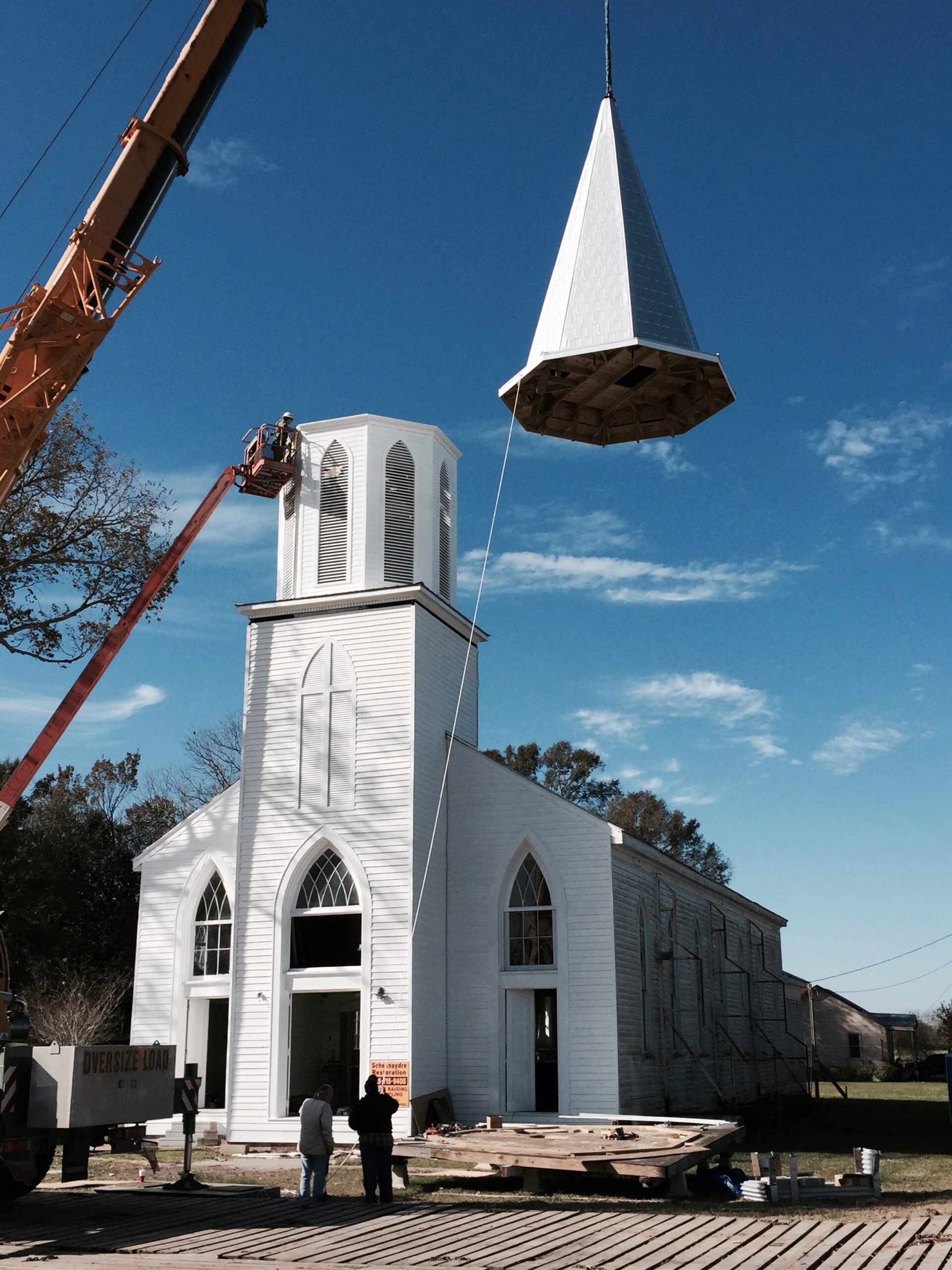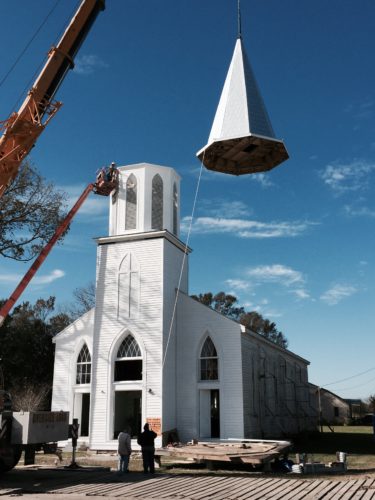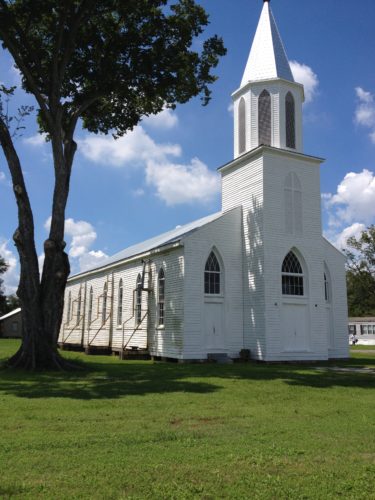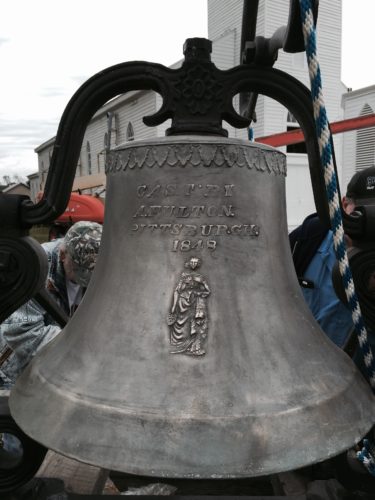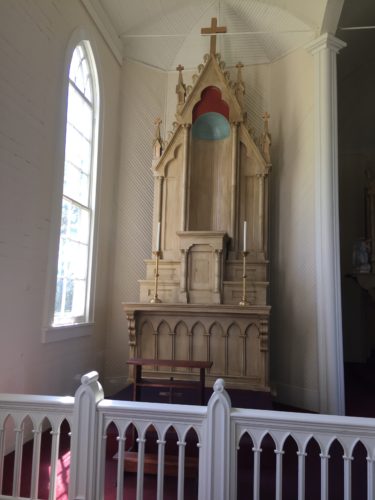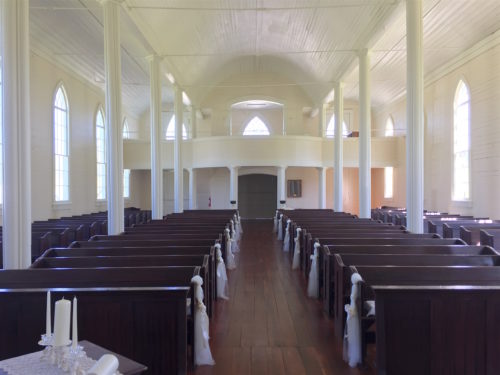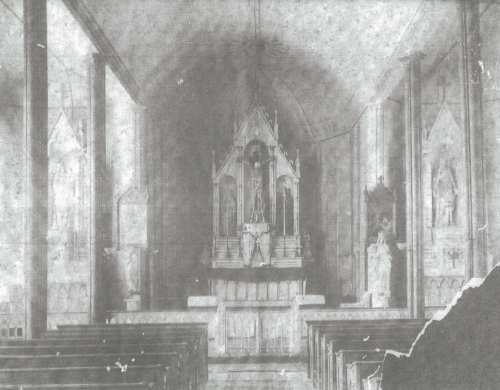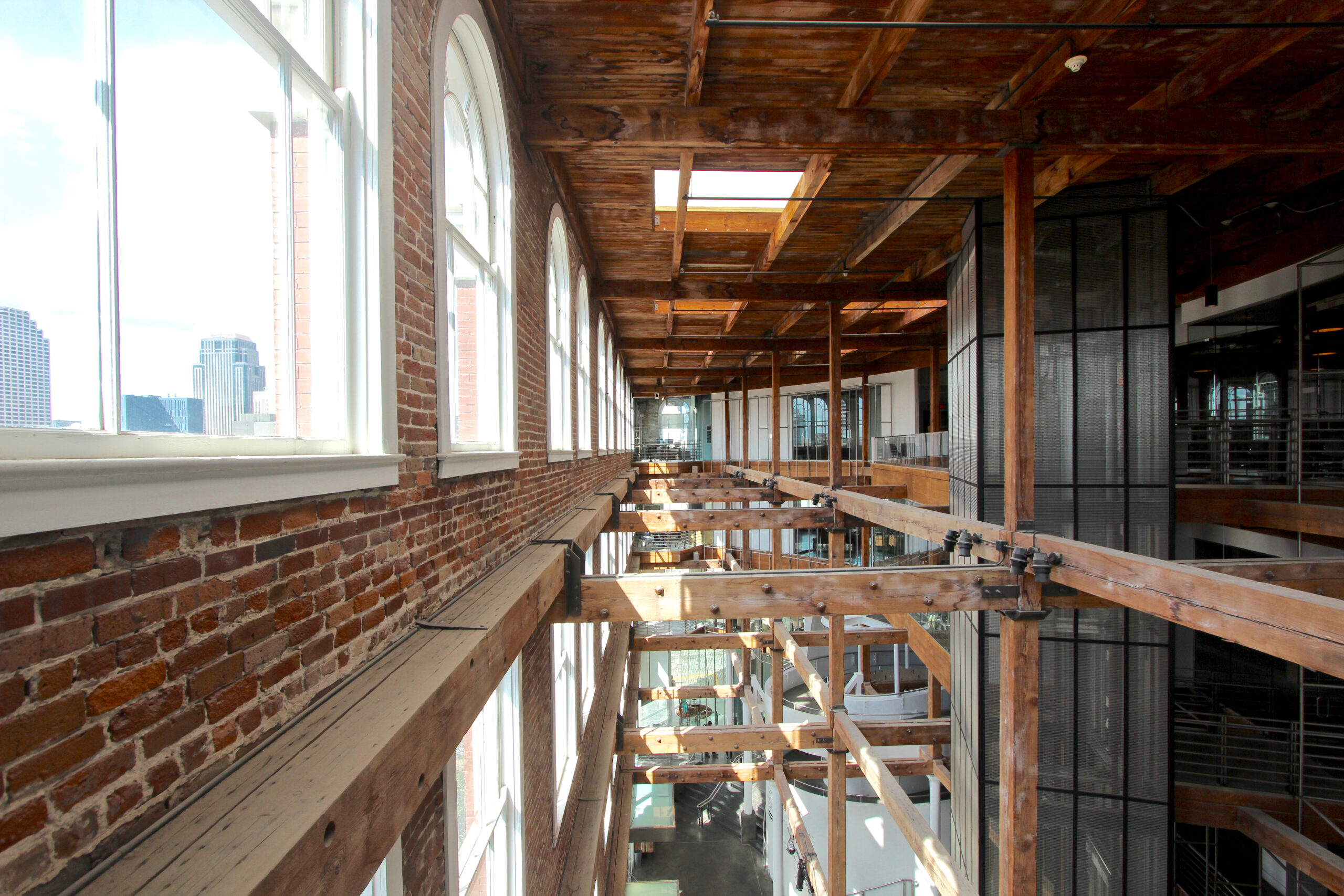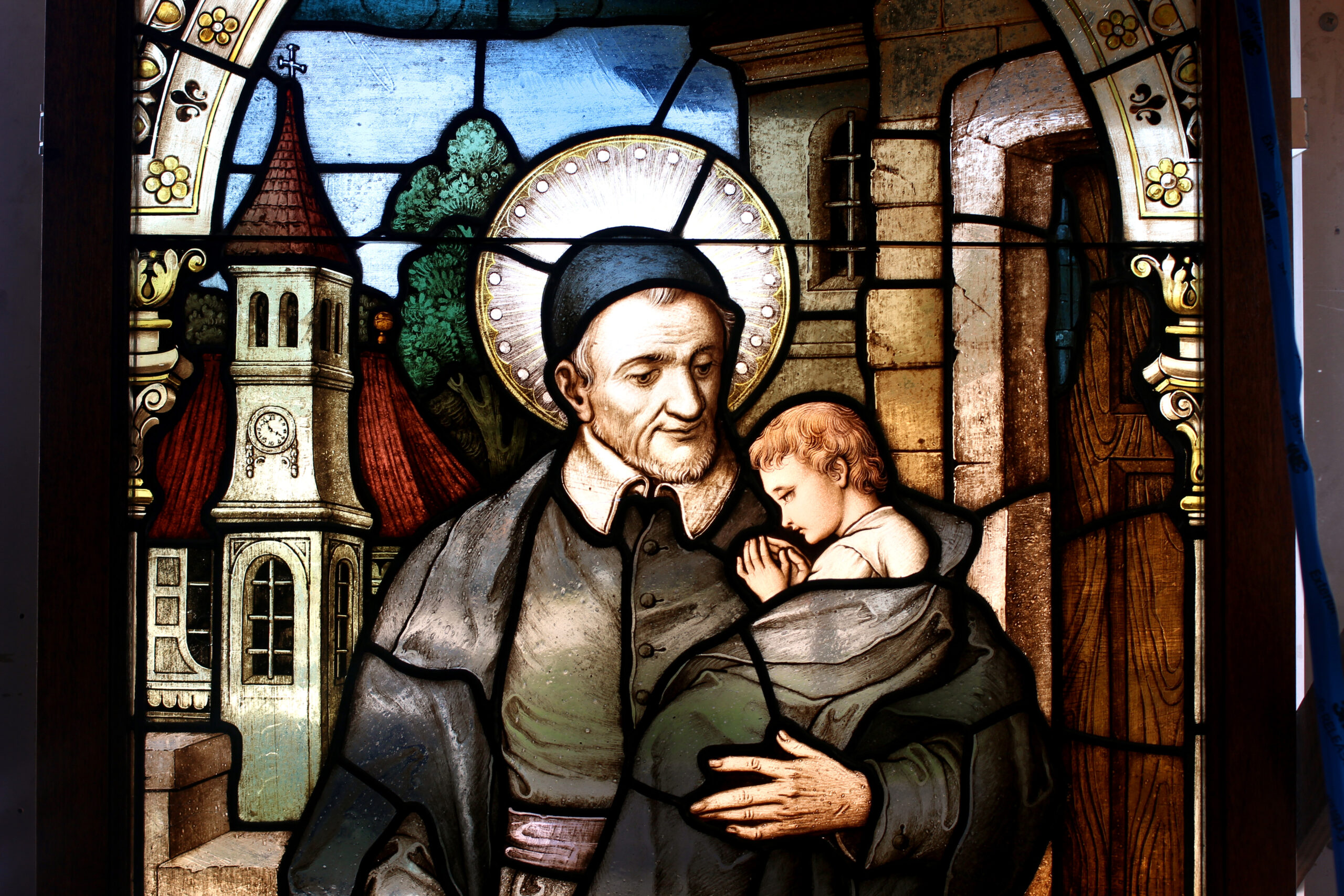The work isn’t even complete, but the restoration of historic St. Paul Catholic Church in Bayou Goula, Louisiana is already winning awards.
In September of 2008, after the high winds of Hurricane Gustav caused St. Paul’s bell tower and steeple to fall onto the main roof of the building, the building sat, enduring further damage from exposure to the elements. The building faced demolition — prompting several concerned community members to form the Friends of St. Paul Church, Inc. Its sole mission is to “stabilize and restore this architectural asset, and return it to working condition, capable of hosting religious and cultural events, thereby providing a source of income to sustain its existence as a useful resource to the Bayou Goula community.”
The restoration of the church is three-quarters of the way complete, and Preserve Louisiana and the Louisiana Trustfor Historic Preservation have already recognized the project. But not only is the restoration impressive — the love that is driving the project is rare. There are no developers or future profits behind this restoration, which may end up costing half a million dollars — just committed community members. And there is no huge benefactor: the majority of that money was raised through small donations. For a community this tight, and for the 10 board members of the Friends of St. Paul Church, restoring this community treasure has been worth the massive effort.
A Community with Deep Roots
Bayou Goula, a small hamlet within the town of White Castle located 25 miles downriver from Baton Rouge in Iberville Parish, was once one of the best known landmarks on the Mississippi River. Early maps of the Mississippi River Valley mark it as one of the first settlements — often listed as Bayagoulas, as on the 1743 map based upon the surveys of Broutin, Vergés, and Saucier. Its prominence of place was a result of the relationship between the native inhabitants and Pierre Le Moyne d’Iberville. Iberville first visited the settlement of the Bayougoula people in 1699 and, acting as guides, members of the tribe accompanied him on his exploratory travels on the Mississippi. At the time of Iberville’s first encounter with the Bayougoula, they cohabitated with the Mougoulacha tribe, close to the present location of the hamlet that now bears their name.
The settlement is of importance to not only the general history of Louisiana but also because it marks the site of the first Catholic mass and church built within the present boundaries of the state. In 1700, 34-year-old Paul DuRu, a Jesuit priest, accompanied Iberville on his journey up the Mississippi River. On March 26 of that year, Iberville passed through the Bayougoula settlement once again but left behind Father DuRu and two Canadians in order to construct a mission. That same day, DuRu negotiated with the tribe in order to construct a Catholic church. On March 28, as construction commenced, Father DuRu performed a Catholic mass for the first time in what is now the state of Louisiana with the two Canadians in attendance.
According to Father DuRu’s journals, the original church was, “more than fifty feet long and about twenty in width. I decided on the plan and the dimensions. In general appearance it is like a ship upside down, and as for the details I could settle only length, width, and the curve of the roof.” In Roger Baudice’s The Catholic Church in Louisiana, he states that the chief of the village “inaugurated the plastering work, dipping moss in clay to cover the wall of the church.” In addition to that bousillage construction, Baudice notes that the walls of the original church were also covered in palm leaf matting. Unfortunately, DuRu would not see the church fully completed; he left for Fort Maurepas with the two Canadians, who had taken ill, right before April 11, Easter Sunday of that year. The church is rumored to have stood only about a year due to tribal wars among the native people of the area.
The settlement would not experience another Catholic mass for 171 years, when the current St. Paul Church was constructed in 1871. In the project overview for the restoration, the Friends of St. Paul Church cite it as being the “last physical link to the Catholic heritage of the area.” Indeed, it also stands as one of the last landmarks in what was once a major port and trade station along the Mississippi River. This remarkable history was the catalyst for the preservation efforts, which came after damage incurred from Hurricane Gustav in 2008.
Generations of Milestones
“When Gustav hit, it was so devastating to everyone in the community,” said Patrick Ishmael, president of the Friends of St. Paul Church Board of Directors. The Victorian Gothic Revival-style building, with its pointed arch windows and towering steeple, had been an integral part of the community since its construction on the now extant North Main Street. It was originally situated in the commercial district of the town lining the river, prior to a levee being constructed in 1929-1930.
According to Albert L. Grace’s Heart of the Sugar Bowl, the twelfth Governor of Louisiana, Paul Octave Hebert,
donated the land fronting the river road for the first site of the church in 1870. The parcel consisted of “one arpent (0.84 acres) and forty-five feet front by a depth of 16 chains (352 yards).” The next year, the Archbishop of New Orleans purchased an additional tract of land for the parish from George M. and J. William Murrell, which expanded the property by seven acres. The cornerstone of the church marks its construction date as 1871. However, the building that we see today is more a reflection of the 1890 total renovation by Father Peter M. L. Massardier, which expanded the original footprint by a third.
With the construction of the levee in 1929, the entire commercial district of the town was uprooted. What was once a bustling downtown with shops and homes fronting the river became the necessary location for protection against flooding by the Mississippi. Many buildings, including St. Paul Church, were relocated further back, but many others were lost. It is believed that the church now sits atop its cemetery footprint, but further investigation needs to be undertaken in order to confirm this.
In addition to the church itself, its current land parcel has also contained a number of auxiliary buildings including a rectory and a school — both of which members of the Friends of St. Paul Church Board of Directors said were demolished in the middle of the last century. Generations of Bayou Goula inhabitants have marked the milestones of their lives on the property. Memories of love, of happiness, and of grief are tied to St. Paul Church and its property. Knowing that, it is not surprising that the community would rally towards saving this structure, which has always been so much a part of their lives.
In November of 2011, the group “acquired the church from the diocese with intent to restore and preserve it to its natural history,” said Ishmael. By outlining a multi-phase plan of priorities to address the damage, they have been working towards that goal for the last six years. Relying predominately on small cash donations and in-kind services, the group has been able to accomplish a remarkable amount. Mike Guillot, the nonprofit’s director emeritus and current board member, said, “Most of the donations have been small donations; that really got us to where we’re at.” With approximately 73 percent of the scope of the project complete, one can begin to understand the magnitude of Guillot’s statement.
The Friends of St. Paul Church board of directors is made of 10 individuals with strong ties to the community and the church building itself, including Antoine J. Landry, who fondly remembers attending the church as a child along with his six siblings. Working together as a team, the board has overseen the impressive restoration work undertaken, as well as doing some of the work themselves. What is truly remarkable, besides the amount of cash and service-based donations that the group has been able to acquire, is the level of craftsmanship in the restoration work. Every detail of the project has been well thought out with the goal of staying as true to the original structure as possible.
Their efforts have not gone without recognition. In 2011, after initially acquiring the church, the group was awarded the “Phoenix Award” from Preserve Louisiana (formerly known as the Foundation for Historical Louisiana). Then, earlier this year, they were awarded the prestigious “2017 Preservation Heritage Award” from the Louisiana Trust for Historic Preservation. The group modestly acknowledges their successes, but stays focused on the work remaining.
In addition to the church itself, its current land parcel has also contained a number of auxiliary buildings including a rectory and a school — both of which members of the Friends of St. Paul Church Board of Directors said were demolished in the middle of the last century. Generations of Bayou Goula inhabitants have marked the milestones of their lives on the property. Memories of love, of happiness, and of grief are tied to St. Paul Church and its property. Knowing that, it is not surprising that the community would rally towards saving this structure, which has always been so much a part of their lives.
In November of 2011, the group “acquired the church from the diocese with intent to restore and preserve it to its natural history,” said Ishmael. By outlining a multi-phase plan of priorities to address the damage, they have been working towards that goal for the last six years. Relying predominately on small cash donations and in-kind services, the group has been able to accomplish a remarkable amount. Mike Guillot, the nonprofit’s director emeritus and current board member, said, “Most of the donations have been small donations; that really got us to where we’re at.” With approximately 73 percent of the scope of the project complete, one can begin to understand the magnitude of Guillot’s statement.
The Friends of St. Paul Church board of directors is made of 10 individuals with strong ties to the community and the church building itself, including Antoine J. Landry, who fondly remembers attending the church as a child along with his six siblings. Working together as a team, the board has overseen the impressive restoration work undertaken, as well as doing some of the work themselves. What is truly remarkable, besides the amount of cash and service-based donations that the group has been able to acquire, is the level of craftsmanship in the restoration work. Every detail of the project has been well thought out with the goal of staying as true to the original structure as possible.
Their efforts have not gone without recognition. In 2011, after initially acquiring the church, the group was awarded the “Phoenix Award” from Preserve Louisiana (formerly known as the Foundation for Historical Louisiana). Then, earlier this year, they were awarded the prestigious “2017 Preservation Heritage Award” from the Louisiana Trust for Historic Preservation. The group modestly acknowledges their successes, but stays focused on the work remaining.
The first major task completed were repairs to the roof and securing the envelope of the building, including the repair of broken windows on the front and side elevations. After the steeple and bell tower fell during the storm, the main body of the church was left exposed to the elements for a full year. When the group acquired the building, it had “termite and water damage and was seven inches out of plumb,” Guillot said.
The replacement of the octagonal steeple and bell tower has been the most challenging aspect of the project. “When they put that steeple in, they built the section on the ground and then had to raise and match it to the section that was up there — and they had an only an inch” of allowable margin of variation,” Landry said. Spanish cedar was used on the bell tower louvers because of its resistance to water damage, but the rest of the siding of the building remains pine — in accordance to the original materials used. Topping the pressed-tin clad, 88-foot steeple spire are replicas of the original ball and cross, recreated by Mike Guillot. Unfortunately, the originals had sustained damage beyond repair; they have been retained and placed into storage. Guillot built the 15-foot cross out of wood salvaged from the damaged bell tower and then clad it in copper to match the original. The cross sits atop a ball constructed out of layered lead. Also, the structure now once again houses its original bell, cast in Pittsburgh by A. Fulton in 1848.
The interior of the church is currently undergoing restoration. The pine flooring has just been refinished, as well as the overall painting of the walls and ceiling. The striking original three-section altar has also just been refinished, having been sanded, painted and reglazed. The group is currently working towards securing additional funding to be able to continue with the addition of heating and air-conditioning, electrical updates and becoming ADA compliant. Once the space is climate controlled, a new pipe organ that was donated by a local family will be placed within and used during the various events held within the building.
After all restoration work on the interior is complete, the group will focus the final effort on the exterior of the structure. Exterior paint, some cladding, and the addition of a more accessible parking area and restroom facility will be addressed.
“We are a team,” Landry said about the nonprofit’s board of directors. This reliance on each other is what has made the project so successful, he emphasized. Each board member has brought a specific skill set with them to the project from their varying backgrounds. However, these skills are secondary to the strong united commitment that they all have to the project’s success.
Board Treasurer Travis Campesi stated that her most cherished aspect of the project has been “that it was accomplished just through donations. That is a gift, a true gift.” With over a quarter of the project yet to be completed the group continues the restoration and fundraising, and hopes others will aid them along the way.
Photo Gallery (click to expand images)
Photos courtesy of Traves Campesi



